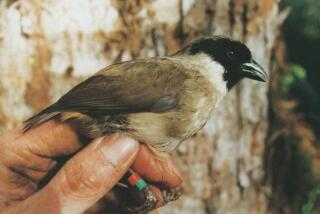25% of wild mammal species are imperiled
- Share via
BARCELONA, SPAIN — At least one-quarter of the world’s mammal species in the wild are threatened with extinction, according to an international survey released Monday that blames the loss of wildlife habitat as well as hunting and poaching for the steep declines.
The survey, assembled over five years by 1,700 researchers in 130 countries, is the most comprehensive yet to assess the status and future of mammals on every continent and in every ocean.
The baiji, or Chinese river dolphin, is teetering on the edge of extinction and may have already joined the list of species that have vanished from Earth. Others are not far behind, such as the vaquita, a small porpoise that has been drowning in fishing nets in the northern part of the Gulf of California; the North Atlantic right whale; and various monkeys and other primates hunted by poachers in Africa.
Scientists have determined that about 25% of the world’s 5,487 species of mammals face extinction. The proportion of marine mammals in trouble appears to be higher, with an estimated one-third under serious threat of being wiped out. Many are killed when they are struck by ships or become entangled in fishing gear and drown.
About half the world’s remaining species of apes, monkeys and other primates face threats from hunting or deforestation to make way for farming, said Russell A. Mittermeier, president of Conservation International.
“Chimp and gorilla meat fetches a higher price in many markets in Central African cities than beef or chicken because it’s considered a luxury item,” Mittermeier said. “We are losing many of these animals that otherwise could survive because they cling to relatively good habitat.”
Scientists find these extinctions particularly worrisome because a diversity of species helps stabilize the planet. Each extinction can disrupt this balance and ripple through the food chain, making it more difficult for other species, including humans, to survive.
The bleak assessment was released in Barcelona at the World Conservation Congress, a meeting of 8,000 scientists, conservationists, business leaders and representatives from governmental environmental ministries. It was part of a larger update to the Red List of all threatened species, maintained by the International Union for the Conservation of Nature, which hosts this gathering every four years.
The Red List has several categories, including extinct; extinct in the wild; and those threatened with extinction, including the critically endangered, endangered and vulnerable.
Jonathan Baillie, director of conservation programs for the Zoological Society of London, said that a sampling shows that 24% of all species of vertebrates -- animals with a backbone -- appear to face the threat of extinction.
Tracking the health and abundance of all species is too massive a job, Baillie said, but he suggested that such sampling might be tantamount to creating a Dow Jones industrial average index for the planet’s biodiversity. In this case though, he said, “there’s no $700-billion bailout on the horizon.”
Holly Dublin, who leads the IUCN’s species survival commission, said more details of the Red List would be unveiled in Barcelona this week as scientists and officials worked on plans to try to reverse the downward slide of so many species. For instance, she said, a clear picture of a species in trouble, along with information about its habitat, could discourage the World Bank from financing a development project that might imperil that species’ existence.
Researchers have sought to make the IUCN’s Red List the most trusted assessment of species vulnerability by accumulating the best scientific information without getting tied up in legal definitions or the politics of any particular nation. The Red List used to be published as a book, but it has grown so long -- now 44,838 species -- that it has evolved into an online catalog at www.iucn.org/redlist.
Still, these assessments are far from an exact science. The La Palma giant lizard was thought to have become extinct in the last 500 years, sometime after the Romans brought rats to the Canary Islands off the northwestern coast of Africa. But it was rediscovered last year, clinging to steep cliff faces out of reach of rats. It’s now listed as critically endangered.
The assessment of marine mammals, the first completed since 1996, did not fully factor in the effects of global warming, the principal scientists said. The results of this study will be published this week in the journal Science.
The prospects for these animals may be worse than even the global numbers suggest, said Jan Schipper of Conservation International, who was the lead author of the Science paper. The problem is what he called a surprising lack of information about 836 mammal species.
“If you don’t know where they are or how many there are, then it’s hard to determine if they have viable populations or [are] threatened with extinction,” Schipper said. Given this uncertainty, as many as 36% of land mammal species and 61% of whale, seal and other marine mammal species could be threatened with extinction.
--
--
On latimes.com
Animals in danger
For photos of more than a dozen endangered mammals, go to latimes.com/world.
More to Read
Sign up for Essential California
The most important California stories and recommendations in your inbox every morning.
You may occasionally receive promotional content from the Los Angeles Times.










